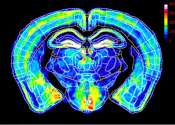X-chromosome inactivation may reduce autism risk, study in mice suggests
A study in mice suggests how chromosome inactivation may protect girls from a type of autism disorder inherited from their father's X chromosome.
7 hours ago
0
13
A study in mice suggests how chromosome inactivation may protect girls from a type of autism disorder inherited from their father's X chromosome.
7 hours ago
0
13

Scientists have unraveled the mechanisms of the cyclic guanosine monophosphate-adenosine monophosphate synthase-stimulator of interferon genes (cGAS-STING) signaling pathway activated by micronuclei, as well as its significant ...
Apr 9, 2024
0
0

Researchers have been chipping away at the genetic causes of congenital heart disease (CHD) for a couple of decades. About 45% of cases of CHD have an identifiable cause, including chromosomal abnormalities, genetic variants ...
Apr 8, 2024
0
12

University of Virginia School of Medicine researchers have discovered a gene on the Y chromosome that contributes to the greater incidence of heart failure in men. The work is published in the journal Nature Cardiovascular ...
Apr 1, 2024
0
49

Researchers at the University of Colorado Anschutz Medical Campus and collaborators across the country have conducted the largest and most diverse study of men with extra X or Y chromosomes in the US using a large dataset ...
Mar 29, 2024
0
26

A team of the University of Barcelona and the Biomedical Research Institute of Barcelona (IRB Barcelona) has designed a new bioinformatics tool to identify the chromosomal alterations that are characteristic of cancer cells.
Mar 21, 2024
0
0

A cross-college collaboration is opening new doors in the study of male infertility by breaking down a key step in sperm formation. Isolating the intricacies of meiotic sex chromosome inactivation (MSCI), will now enable ...
Mar 12, 2024
0
16

Daughters inherit two X chromosomes (one from the mother and one from the father), while sons inherent an X chromosome only from the mother. In new research published in Molecular Cell, investigators at Massachusetts General ...
Mar 11, 2024
0
23

Early in the development of sperm, a strange event happens: the X and Y chromosomes condense into tight packages and are sequestered away from the other 44 human chromosomes. If any part of this process goes awry, the cells ...
Feb 22, 2024
0
25

A new research paper titled "Differential expression of Mad2 gene is consequential to the patterns of histone H3 post-translational modifications in its promoter region in human esophageal cancer samples" has been published ...
Feb 12, 2024
0
0

A chromosome is an organized structure of DNA and protein that is found in cells. It is a single piece of coiled DNA containing many genes, regulatory elements and other nucleotide sequences. Chromosomes also contain DNA-bound proteins, which serve to package the DNA and control its functions. The word chromosome comes from the Greek χρῶμα (chroma, color) and σῶμα (soma, body) due to their property of being very strongly stained by particular dyes. Chromosomes vary widely between different organisms. The DNA molecule may be circular or linear, and can be composed of 10,000 to 1,000,000,000 nucleotides in a long chain. Typically eukaryotic cells (cells with nuclei) have large linear chromosomes and prokaryotic cells (cells without defined nuclei) have smaller circular chromosomes, although there are many exceptions to this rule. Furthermore, cells may contain more than one type of chromosome; for example, mitochondria in most eukaryotes and chloroplasts in plants have their own small chromosomes.
In eukaryotes, nuclear chromosomes are packaged by proteins into a condensed structure called chromatin. This allows the very long DNA molecules to fit into the cell nucleus. The structure of chromosomes and chromatin varies through the cell cycle. Chromosomes are the essential unit for cellular division and must be replicated, divided, and passed successfully to their daughter cells so as to ensure the genetic diversity and survival of their progeny. Chromosomes may exist as either duplicated or unduplicated—unduplicated chromosomes are single linear strands, whereas duplicated chromosomes (copied during synthesis phase) contain two copies joined by a centromere. Compaction of the duplicated chromosomes during mitosis and meiosis results in the classic four-arm structure (pictured to the right). Chromosomal recombination plays a vital role in genetic diversity. If these structures are manipulated incorrectly, through processes known as chromosomal instability and translocation, the cell may undergo mitotic catastrophe and die, or it may aberrantly evade apoptosis leading to the progression of cancer.
However, in practice "chromosome" is a rather loosely defined term. In prokaryotes, a small circular DNA molecule may be called either a plasmid or a small chromosome. These small circular genomes are also found in mitochondria and chloroplasts, reflecting their bacterial origins. The simplest chromosomes are found in viruses: these DNA or RNA molecules are short linear or circular chromosomes that often lack any structural proteins.
This text uses material from Wikipedia, licensed under CC BY-SA